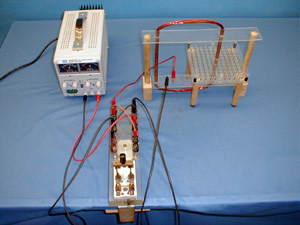Demos: 6B-03 Magnetic Field Around A Wire

(a) A large wire loop, consisting of many turns of copper wire is surrounded by an array of tiny compass needles. The needles are on posts that are arranged in a pattern of concentric circles around a straight segment of the loop. When there is no current in the wire, the needles align themselves in a somewhat random orientation, based entirely on their interactions with each other. When a large current is passed through the wire loop, the needles arrange themselves in a somewhat circular pattern, indicating that there is a magnetic field surrounding the wire and that it consists of concentric circles (see Demo 6B-01)
(b) In the second part of the demonstration, the compass needles are replaced by a transparent plastic plate upon which iron filings may be sprinkled. The circular pattern around the wire is clearly visible.
Directions: (a) Set the apparatus on the overhead projector (or use the projection camera). The wire loop is connected to a power supply that produces a large DC current. When the power supply is engaged a noticeable change takes place in the orientation of the compass needles. Focus on this change by alternately opening and closing the circuit.
(b) Set the apparatus on the overhead and connect it to the power supply. After turning on the current, sprinkle iron filings gently onto the plate, tapping the plate gently as you do it. Once the pattern has clearly emerged, discontinue the sprinkling to avoid smearing out the pattern.
Suggestions for Presentation: If you have used Demo 6A - 01 previously, refer to the results and then indicate that you will now give some visible evidence that the field around the wire is shaped in concentric circles. Point out that because of the finite length of the needles, one cannot get a true circular pattern; however, the approximation is quite good and the students think this is a neat apparatus! By removing the compass needles and sprinkling the iron filings on the plate, a more continuous pattern develops.
Applications: Precursor to such devices as electromagnets and solenoids, for example.
Last Updated: Nov 30, 2023 11:25 AM